Can Marigolds Stay Outside? Tips for Outdoor Care
If you’re thinking about adding marigolds to your garden, you might wonder if they can stay outside all year. Marigolds are quite hardy and can remain outdoors as long as the frost has passed. This makes them a great choice for any gardener looking for easy-to-grow and low-maintenance flowers. Their bright blooms will add a splash of color to your space.
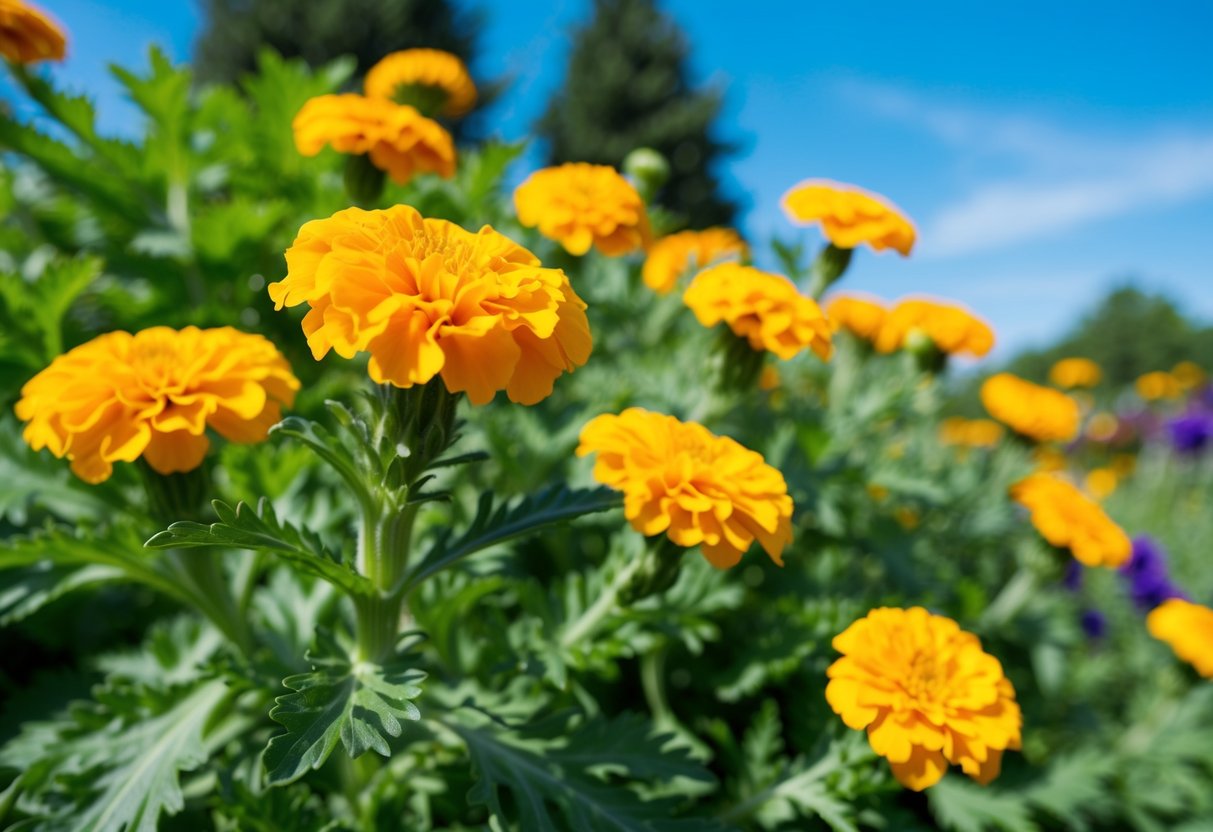
You’ll find that marigolds are tough plants, thriving in various conditions. Whether you’re planting marigold seeds or starting with young plants, it’s best to wait until the threat of frost is gone before setting them in the garden. Marigolds can even deter garden pests, providing a natural benefit to your garden.
These cheerful flowers belong to the Tagetes family and are a favorite for their resilience and vibrant colors. You don’t need to fuss over them too much, making them perfect for both budding and experienced gardeners alike. Enjoy a stunning, pest-free garden with the help of marigolds.
Understanding Marigolds

Marigolds are vibrant flowers that brighten gardens and offer pest-repelling benefits. These flowers come in various types, and knowing their basic care needs ensures a thriving garden.
Types of Marigold
Marigolds come in several varieties, each with unique characteristics. French marigolds (Tagetes patula) are known for their compact size, making them great for borders. They have vibrant colors like red, orange, and yellow.
African marigolds (Tagetes erecta) grow taller, often reaching over two feet, with large, showy blooms. They are perfect for the back of garden beds.
Signet marigolds (Tagetes tenuifolia) have smaller flowers and a citrus fragrance, ideal for culinary uses. Lastly, pot marigolds (Calendula officinalis) are often used for their edible petals and medicinal properties, although they are botanically different from the other types.
Marigold Basics
Growing marigolds is quite simple. They thrive in full sun and well-draining soil. Plant seeds about an inch deep and keep the soil moist until germination, but not waterlogged to avoid root rot.
Space the plants according to their variety: French marigolds benefit from close spacing, around 6-12 inches. African marigolds need more room, about 12-24 inches, to accommodate their larger size.
Avoid heavy fertilization, as this can lead to lush foliage but fewer blooms. Regular deadheading helps keep the flowers blooming all season. By following these basic care tips, your marigolds will add beauty and charm to your garden.
Planting and Propagation
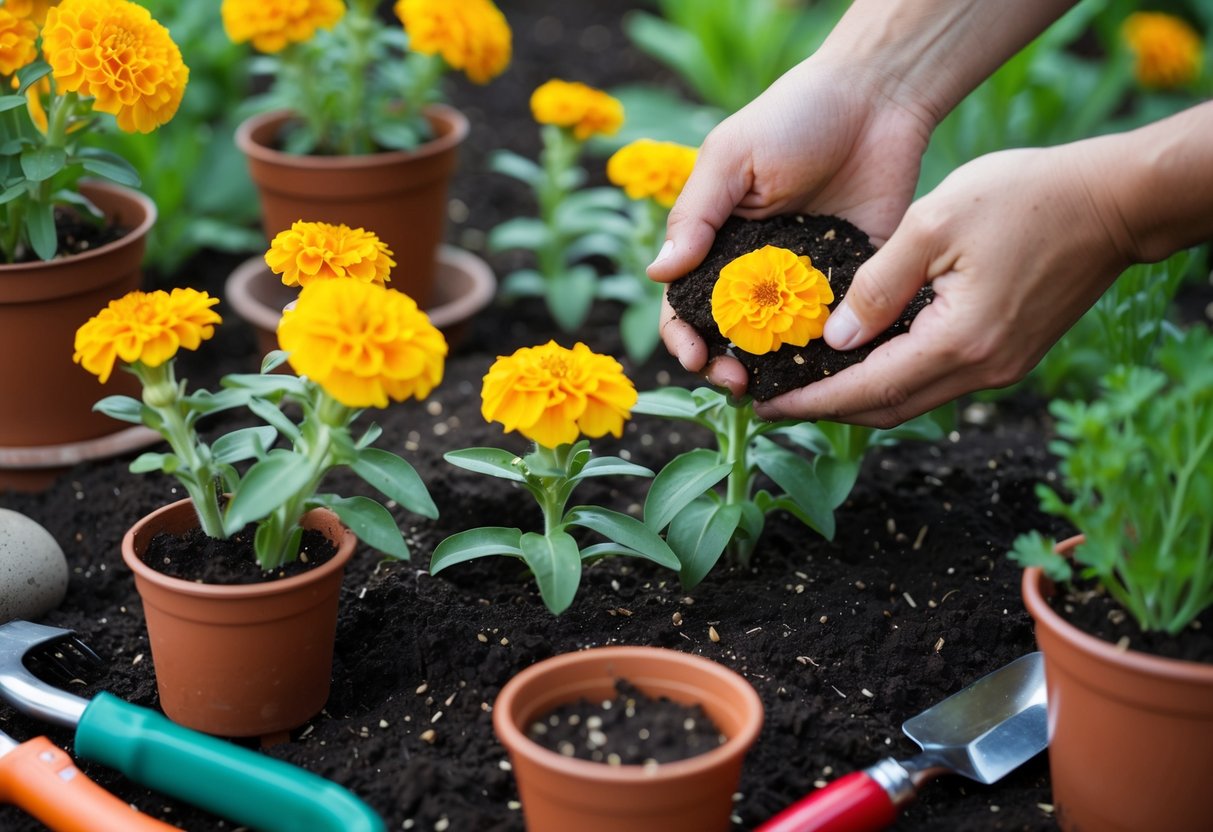
Planting marigolds is a simple process that begins with sowing seeds and extends to careful transplanting. Understanding key tips for propagation will help you ensure successful growth and vibrant blooms.
Sowing Marigold Seeds
Sowing marigold seeds is an easy way to start your garden. You should wait until the threat of frost is over before sowing the seeds. Sow them directly in the soil about an inch deep and one inch apart. Keep the soil moist to assist germination. Marigolds prefer a neutral pH of 6.0 to 7.0, so make sure the soil fits this range for the best results.
The seeds will typically germinate in about a week if the temperature is right. You can also start seeds indoors a few weeks before the last frost, using containers with good drainage. This method gives you a head start on the growing season. Remember: provide ample sunlight for the seeds to avoid leggy seedlings.
Transplanting Young Marigolds
Once your marigold seedlings are sturdy, it’s time to transplant them. Choose a sunny spot in your garden, as marigolds thrive in full sun. Space the plants 6-24 inches apart, depending on the variety. This allows them room to grow and prevents overcrowding.
Before transplanting, water the seedlings well to make sure they are hydrated. Gently remove them from their pots, being careful not to damage the roots. Dig a hole in the garden slightly larger than the root ball and place the plant in it. Firm the soil around the base to support the young plant. Water thoroughly after planting to help it settle.
Key Tips for Propagation
When propagating marigolds, remember that patience and care are essential. Avoid fertilizing young marigolds, as too much nutrition can lead to excess foliage rather than flowers. Ensure soil drainage is good to prevent root rot, a common issue affecting marigolds.
Monitoring temperature is crucial, especially in cooler climates. Marigolds do best when temperatures stay above 55 degrees Fahrenheit. Cold snaps can stunt growth or even kill young plants. Over time, you will notice stronger plants with lush blooms, ready to brighten up your garden. Keep these tips in mind, and you’ll have a thriving display of colorful marigolds in no time.
Caring for Marigolds
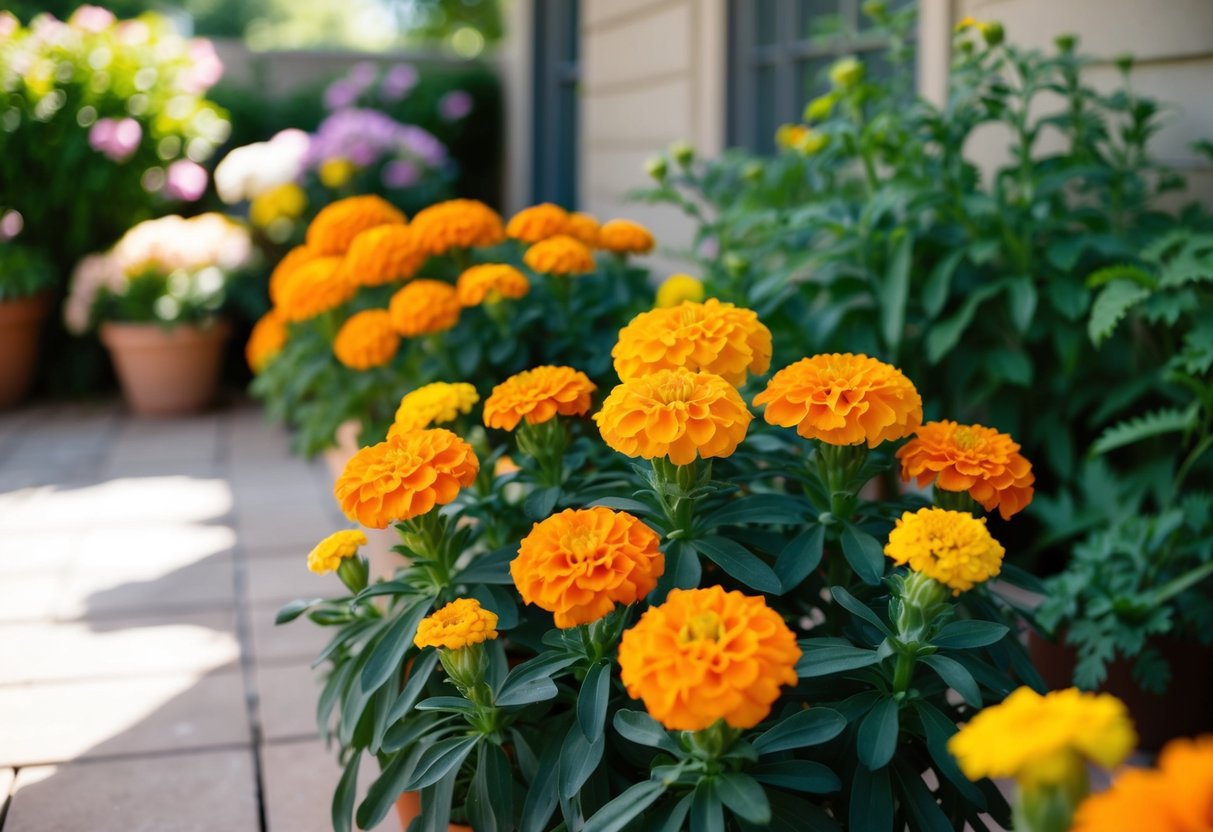
To ensure your marigolds thrive, you need to pay attention to their water and nutrition needs, sunlight and soil conditions, and regular maintenance. Each of these factors is key to keeping your marigolds healthy and vibrant.
Watering and Nutrition
Marigolds are quite drought-tolerant, but they still need consistent moisture to grow well. You should water them deeply, allowing the soil to dry out slightly between waterings. It’s a good idea to water at the base of the plant to avoid wetting the leaves, which can lead to fungal issues.
During dry periods, increase watering to keep your marigolds healthy. Fertilizing them every 4-6 weeks with a balanced fertilizer will provide the nutrients they need. Use well-drained soil to prevent waterlogging, which can harm the roots. Check for pests like aphids regularly. Healthy plants attract fewer pests and can resist disease much better.
Sunlight and Soil Requirements
Marigolds love the sun! They need full sun to produce their vibrant blooms, so plant them in a sunny spot where they’ll get at least 6 hours of sunlight daily. The soil should be well-draining and rich in organic matter for the best growth.
Ideal soil pH for marigolds is slightly acidic to neutral, ranging from 6.0 to 7.0. If your soil is heavy or clay-like, consider adding sand or compost to improve drainage. Good soil conditions help marigolds absorb nutrients more efficiently, supporting plenty of blooms and healthy foliage.
Deadheading and Maintenance
Regular maintenance keeps your marigolds looking their best. Deadheading, or removing spent blooms, encourages the plant to produce more flowers. Simply pinch off or cut the faded flowers just above the nearest set of leaves.
This simple task not only makes your marigolds look tidier but also promotes continuous blooming throughout the growing season. Watch for any signs of disease or wilting leaves and remove them promptly. Keeping your marigolds’ area tidy and free from debris will reduce the risk of pests and diseases affecting your plants.
Protecting Marigolds from Pests and Disease
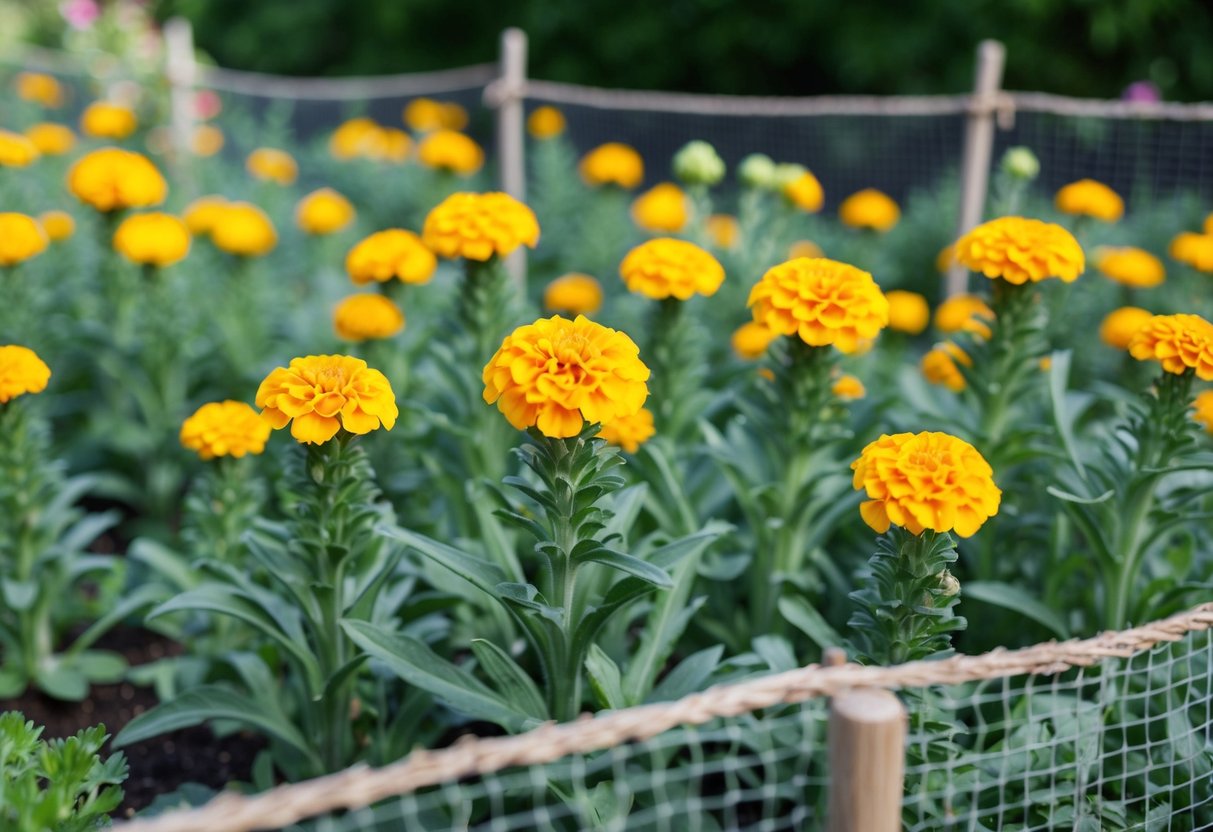
To keep your marigolds healthy and vibrant, managing pests and diseases is crucial. Learn about common pests like aphids and thrips, as well as diseases such as powdery mildew and leaf spot. Knowing how to prevent and treat these issues will ensure your marigolds thrive.
Common Marigold Pests
Marigolds can attract several garden pests. Nematodes, although often deterred by marigolds, can sometimes become a problem. Aphids are tiny green insects that weaken plants by sucking sap. Their presence often leads to sticky honeydew on leaves.
Thrips and whiteflies also target marigolds. These insects cause damage by sucking plant juices, leading to yellow or brown speckling on leaves.
Other pests include beetles and tomato hornworms. Beetles chew on leaves, making holes, while hornworms are caterpillars that can quickly strip away foliage.
Tips for Deterring Pests:
- Introduce natural predators like ladybugs.
- Use insecticidal soap to control soft-bodied insects.
- Regularly inspect plants for signs of infestation.
Disease Prevention for Marigolds
Marigolds are relatively resilient, but they can suffer from diseases like powdery mildew and leaf spot. Powdery mildew appears as white patches on leaves and stems. It’s a fungal disease that thrives in humid conditions.
Alternaria leaf spot is another common problem, causing dark spots on leaves. Good air circulation and avoiding overhead watering can help prevent this disease.
To keep marigolds healthy, regularly check for signs of disease and remove affected leaves. Ensure proper spacing when planting to improve air flow.
Disease Prevention Tips:
- Water at the base of the plant to keep foliage dry.
- Rotate crops to reduce the buildup of soil-borne pathogens.
- Use mulch to prevent soil splash, which can spread diseases.
Utilizing Marigolds in the Garden
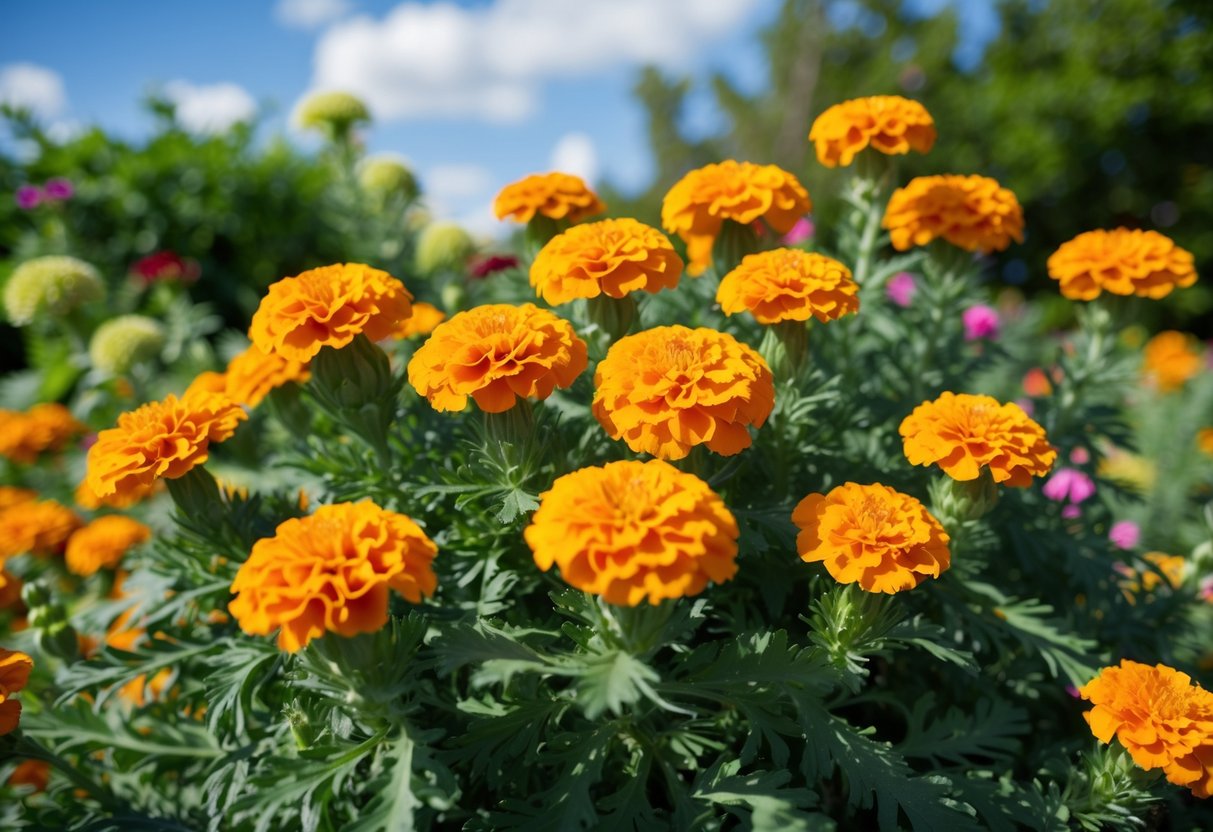
Marigolds are not only colorful additions to your garden but also serve various practical purposes. They are excellent for companion planting and can attract helpful pollinators and insects, improving the overall health of your garden.
Marigolds as Companion Plants
Marigolds are popular for companion planting in a vegetable garden. They help repel certain pests like nematodes, reducing the need for chemical pesticides. Placing marigolds between your crops forms a natural barrier against these harmful organisms. You can plant them in rows or individual spots throughout your garden.
Incorporating marigolds in your landscape also adds visual appeal. They can be paired with vegetables like tomatoes, peppers, and beans. The vibrant flowers not only enhance your garden’s beauty but also support the growth of your other garden plants.
Attracting Pollinators and Beneficial Insects
Marigolds attract various pollinators such as bees and butterflies. These insects are vital for the pollination of other plants in your garden. The flowers provide essential nectar, supporting the survival of these insects. More pollinators mean better fruit and vegetable production.
In addition to pollinators, marigolds draw in beneficial insects. These creatures, like ladybugs, prey on garden pests. This natural pest control can help you maintain a healthy garden ecosystem without resorting to harsh chemicals. Your garden thrives as marigolds invite and sustain these helpful insects.
Incorporating marigolds makes your garden colorful and more productive. Consider planting them for these practical advantages.







